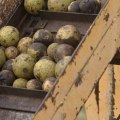While there have been reports of nut shortages in the United States and many other countries, it is inaccurate to say that there are significant repercussions on the global walnut market. This is due to the fact that most of the shortage has been precisely covered by an increase in demand for Chinese nuts. Enable JS and turn off any ad blocker. Analysts at Rabo AgriFinance have released a five-year outlook for walnuts, and the market seems to be flattening out after record growth.
However, there are promising signs for long-term market opportunities, despite a tumultuous year for port congestion, supply chain contraction and a drought that could deepen. The current situation of the market for nuts from specialized farms shows aspects that are completely new compared to the recent past. This is due to the fact that Italian production is increasing, with yields per unit area of up to 30% above the average, and the fact that US production is also increasing, but it no longer has China as a point of sale, which means that the product reaches Europe at low prices. In addition, the pandemic has reduced consumers' purchasing power.
Walnuts can be sold all year round, if stored properly, that is, in low light and in isolated environments. In addition, consumers should know that walnuts can be frozen, since they have a low water content and a good fat component. They do not “freeze”, but retain their initial characteristics for a long time. Domestic production is not enough to meet demand, but foreign competition is so aggressive in terms of volumes and prices that domestic nuts must elbow their way.
It is also true that most consumers know very little or nothing about the work that goes into obtaining high-quality products. But this lack of knowledge is partly our fault, since we have never communicated enough. I think we need to organize ourselves so that consumers know all the peculiarities of our production chain, including the environmental value of our production protocols. We ask you to fill in all text fields marked with *.
ESCALON, California Workers manually sort shelled walnuts along conveyor belts at GoldRiver Orchards, a family-owned nut producer in Escalon, California, U. Tree nuts, led by almonds, walnuts and pistachios, were estimated at 4.5 billion pounds without shell, up 24% from the previous season. Nuts have a short shelf life compared to many commodities, so it's a race against the clock to load them onto cargo ships and ship them to consumers abroad. As the area of walnut continues to increase, she attributes most of the drop in crop size this year to Mother Nature.
As the first week of November began, producers in Butte County were pushing to finish harvesting their walnut crop ahead of the rain forecast for later in the week. As previously reported by Western Farm Press, walnut production is expected to decline from last year's record 785,000 tons. Until the processors were able to catch up, the growers left their nuts in the trees, waiting for the right moment while waiting for the empty trailers to take away the nuts. Increased competition for walnuts could drive new collaborations with some Chilean exporters, allowing the industry to grow and expand to new markets, benefiting food manufacturers and retailers with a more reliable supply.
Some trees that are next in line to be felled and dried, and then sent to the wood chipper, are starting to form their nuts, but they won't be standing long enough for them to form. It is particularly a problem for walnuts, which are in high demand in Europe for the Christmas holidays. But a trip to bring walnuts from California to Europe can pay only a fraction of that and require a month or more of travel. Branch by branch, acre by acre, walnut trees that were on site for more than a decade at Bullseye Farms in Woodland are now destroyed.
A positive aspect of the growing competition is that having more good quality nuts could increase demand. .


